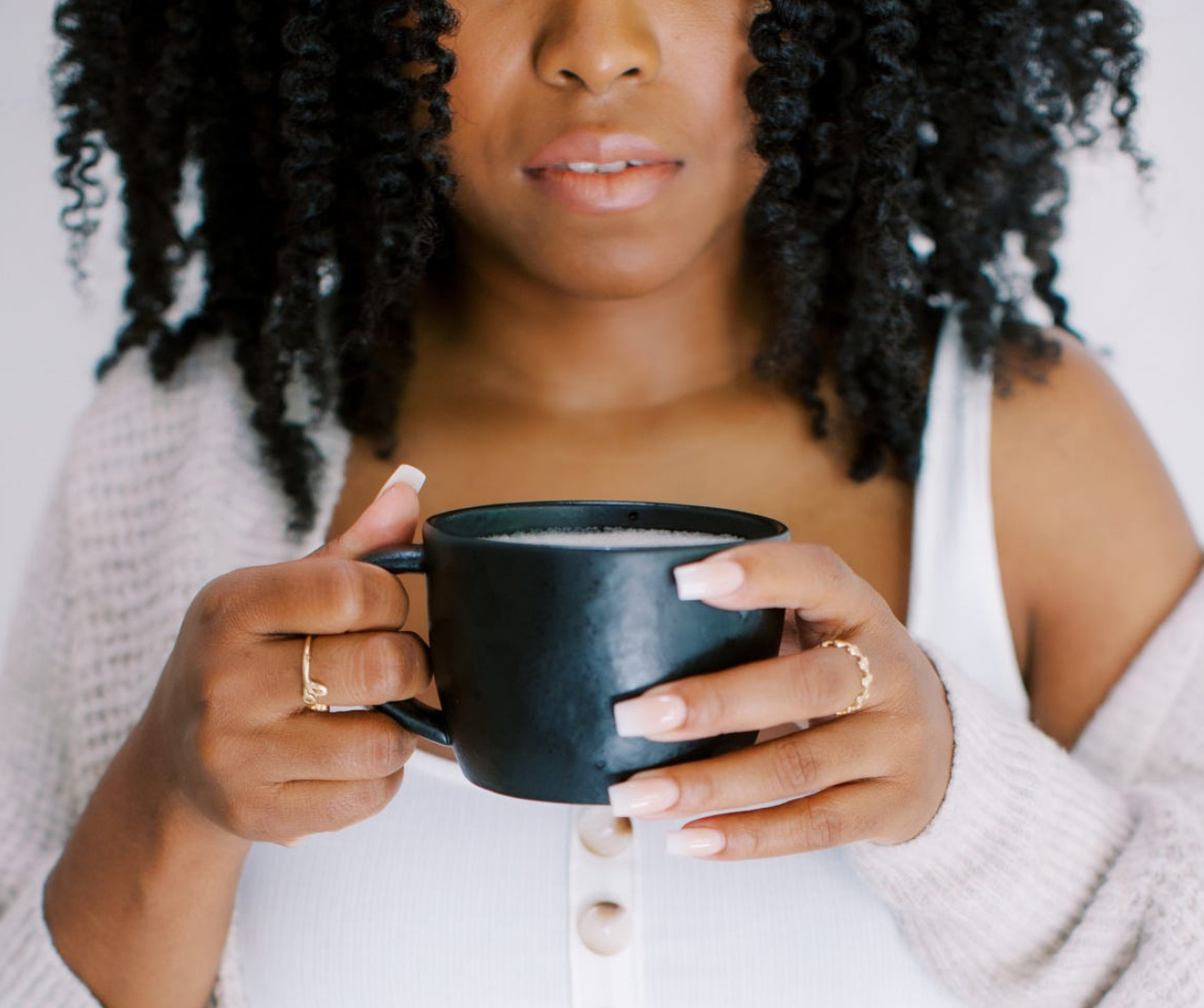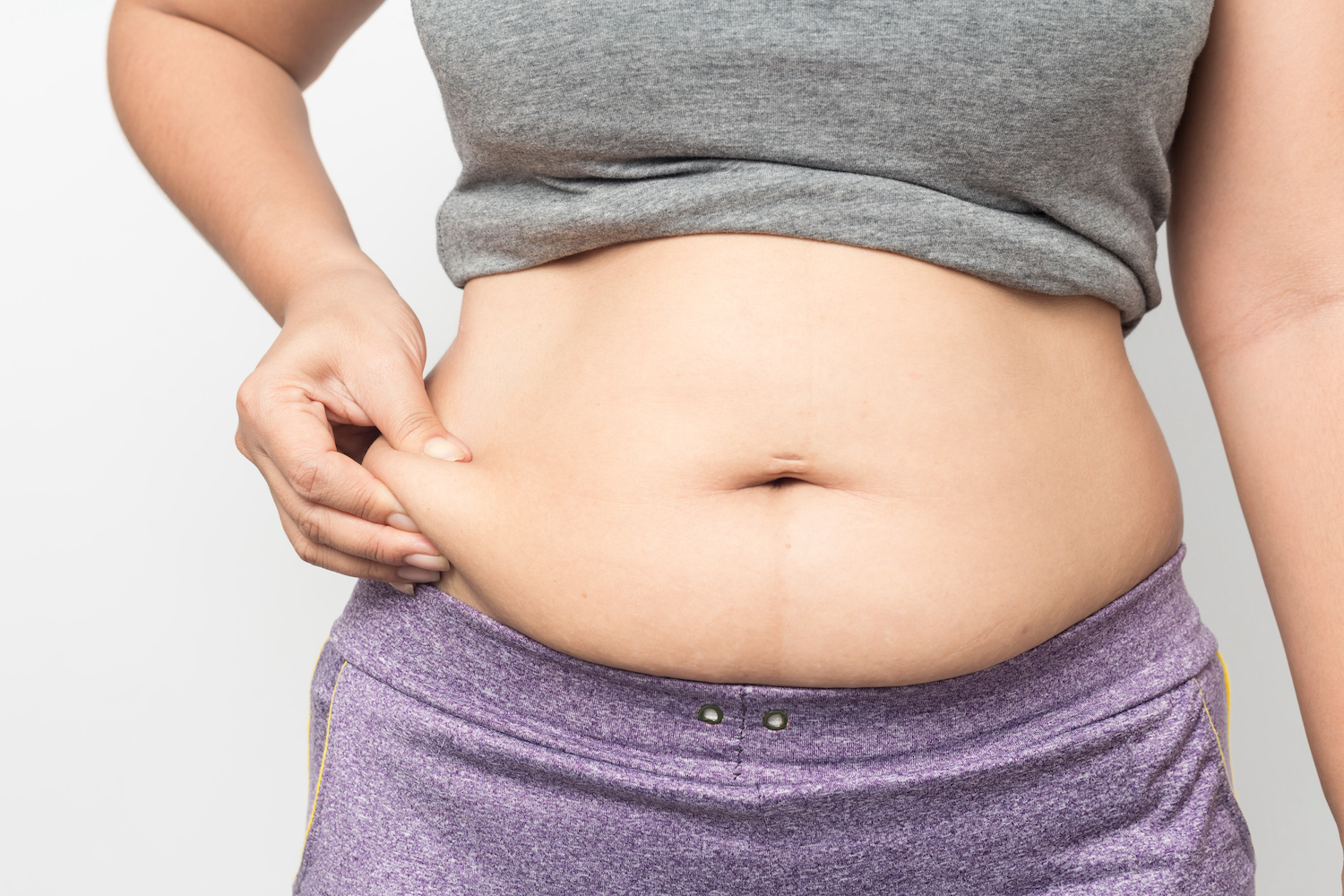
Belly fat: Why we women gain weight around our midsections in our 40s and 50s
If you’re like me, you’ve tried all the old ways you used to depuff that midsection bloat — to no avail. My belly seems to have a life of its own, just hanging out, no longer responding quickly to the fasts or cardio stints that worked only 10 years ago.
Of course it’s not. In our mid-forties, we experience so much change in the way our bodies operate that changing with it is the only way to honor our age — and see the results of our health efforts.
The belly I speak of is not the low, excess skin from babies or a C-section, and it’s not the poof you feel the morning after a sodium-rich dinner: This belly is the kind that somehow became a part of my silhouette (I’m currently 47), a no longer flat-ish core that makes oversized band Ts my most fitting fashion vibe.
Two types of belly fat: Subcutaneous and visceral
For someone with a weak stomach (like myself), looking at photos and even illustrations of belly fat can make you queasy. The little blobs of yellow-hued fat cells smooshed against your skin and organs form two different types of fat: subcutaneous and visceral. Both fats are biologically active, meaning they have an effect on overall body function. More specifically, the fats reside as an endocrine organ (what!) in our bodies, where their hormones affect the neighboring cells and tissues involved in metabolism, further influencing the ways our bodies process disease.
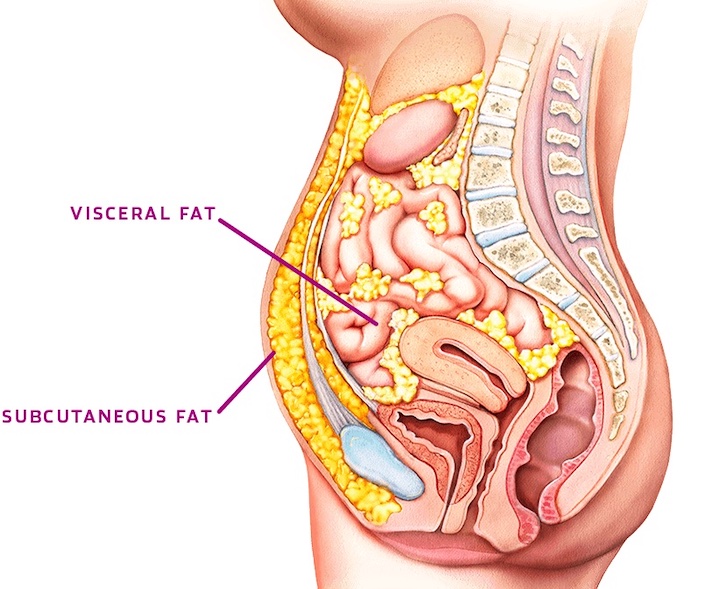
What is subcutaneous fat?
This fat lies in a layer just beneath the skin and has many functions like protecting muscles, helping blood vessels and nerves move from skin to muscles, controlling your body temperature, and attaching your skin to your muscles and bones with connective tissue.
What is visceral fat?
This fat lies beneath our abdominal walls, surrounding our liver, intestines, and other organs. Researchers have linked visceral fat to a wide variety of diseases, low-level inflammation, heart disease, and other chronic conditions. This is the fat that can really harm us.

The science behind gaining belly fat during perimenopause and menopause
As if perimenopause isn’t already weighing us down! Beyond the hot flashes, restless nights, and mood swings, we also have fat types and our metabolism (the chemical processes that occur when your body converts food into energy) to think about.
Estrogen
Our estrogen – essential for metabolically intensive activities like baby-making – starts to take a nosedive, typically in our mid-40s. This decrease during perimenopause correlates to the loss of subcutaneous fat and an increase in visceral fat, turning our “pear” body shapes into round “apples.”
Testosterone
For years, researchers thought that a dip in estrogen was the main factor affecting perimenopausal women’s added belly fat – that estrogen protected against it. What they’ve come to find out is that the increase in active testosterone is predominantly responsible for visceral fat – and for the increased risk of cardiovascular disease associated with it.
Muscle
While losing estrogen and testosterone, we’re gaining years – another reason for our metabolism decline. More specifically, as we get older, we lose muscle mass. Since muscle burns calories, we now burn fewer calories than we used to, so we gain fat (especially if we maintain the same lifestyle habits). Plus, studies show that our activity levels decrease as we mature, which obviously impacts our weight as well.
Sleep
Did I mention restless nights? Lack of sleep contributes to big bellies because we can’t get a good workout when we’re tired, hungry, and cranky. Plus, low energy from insufficient slumber causes us to become hungrier and adopt less healthy diets (such as quick energy fixes like sugar and carbs), not to mention, have more time in the day to snack. And then it becomes another night, another day, another pound.
Genes
Lastly, look at Mom and Dad. Do they store fat in their, err, jeans? (Couldn’t resist.) While their bellies aren’t crystal balls, if you’re starting to mirror your folks, scientists say that genetics could be partially to blame.
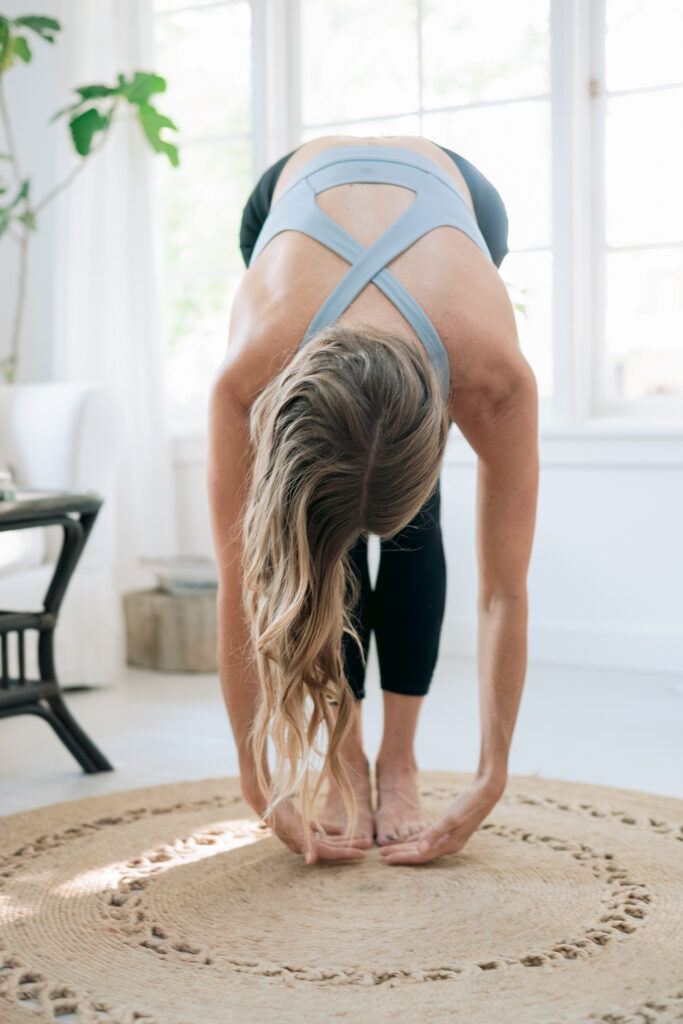
What are the risks of weight gain for women in their 40s and 50s?
Tight jeans are no joke. But when our health also gets taken out, then we have some serious lifestyle choices to consider. When we women gain extra weight, particularly around menopause, we can increase our risk for some scary health issues, including:
- Metabolic syndrome (a group of conditions that raise your risk of serious health problems like coronary heart disease, diabetes, stroke, and more)
- Breathing problems and asthma
- Heart and blood vessel disease
- Type 2 diabetes
- Dementia
- Breast, colon, and endometrial cancers
Luckily, diet, exercise, sleep, and less stress (you know, all those things that come easily to us!) can help make not putting on belly fat in our 40s and 50s non-negotiable.
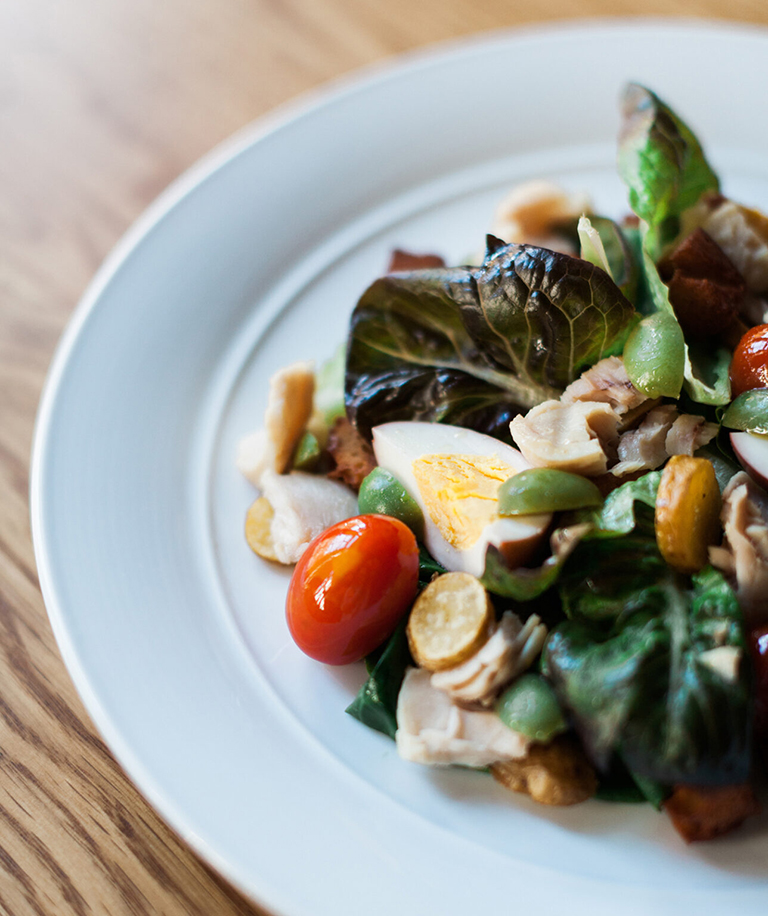
Best foods to eat – and not eat – to keep a healthy waistline
The old saying, “Abs are made in the kitchen, not the gym,” certainly holds true here. Since different foods have different effects on our hormones, brain responses, and energy expenditure, we need to consider nutrition to prevent weight-gain and consequential health issues when choosing what to eat:
Eat more fiber
Eating 180 calories worth of nuts versus 180 calories of pizza, for example, affects our bodies very differently: The fiber in nuts doesn’t break down easily during digestion to fill us up for longer — while the pizza has us immediately reaching for another slice (due to its low fiber content).
Eat more fruits and vegetables
The water and fiber in fruits and vegetables will add volume to your dishes, filling you up with fewer calories. Plus, these delicious, nutrient-dense foods are rich in antioxidants to prevent cell damage. They include dark green leafy vegetables like spinach, kale, and broccoli and brightly hued fruits like mangos, cherries, and berries – and so many more.
Eat lean protein
Research shows that people who eat more protein tend to have less abdominal fat than those who eat a lower protein diet. Eating healthy protein like eggs, nuts, fish, and more can help boost your metabolism, reduce hunger, and regulate blood sugar levels. Plus, when we start to lose estrogen in our 40s and 50s, we also lose muscle mass, and protein can help to preserve our muscles, strength, and bone health to boot.
Forget the Western diet
Americans eat so much junk, consisting of empty calories, or foods made of solid fats or added sugars, that can cause weight gain, inflammation and disease. Avoid the Western diet, which includes pre-packaged foods, red and processed meats, sugary drinks, fried foods, high-fat dairy products, and so much more.
Limit alcohol
Booze is another form of, you guessed it, empty calories. Moreso, alcohol stops your body from burning fat and can also make you hungry and crave greasy and salty foods.
P.S. Don’t smoke
Besides the obvious health risks, if you smoke, you’re more likely to store fat in your abdomen rather than on your hips and thighs. Who knew?
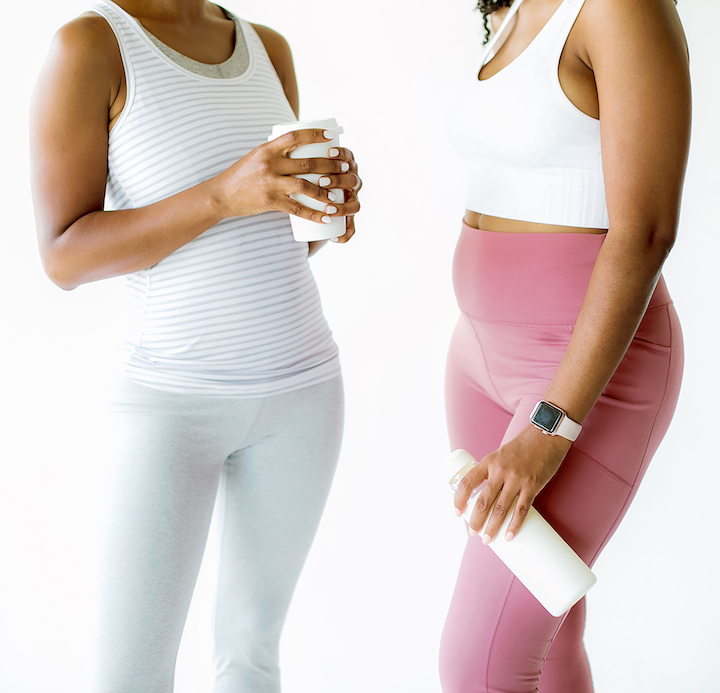
What’s the best exercise to lose belly and body fat?
Even though abs are made in the kitchen, you’re not going to lose that belly with diet alone. Doing aerobic exercise while being mindful of your diet is the best way to lose belly fat – and body fat in general.
Aerobic exercise
Getting your heart pumping – not doing 100 crunches! – will help you melt away that fat. Research confirms that consistently doing moderate to intensive exercise 150 minutes per week will contribute to this weight loss over the long term. This doesn’t mean that you have to run for 2.5 hours a week; many low-impact exercises like walking, biking, swimming, dancing and more will also do the trick. The key here is consistency.
Strength training
Strengthening our muscles in our 40s and 50s critically affects our metabolism and future physical abilities. I dug deep into this importance and ways to achieve results in my recent article, Strength training: Why women in their 40s need to start now.
Mindfulness
What we think we are is who we are. Anyone who practices mindfulness knows this to be true, and this sentiment is just as important in our health journeys as it is in any other part of our lives. According to a recent study, overeating has more to do with our minds than our emotions. We tend to overeat when we’re stressed, bored, and lonely, and over time, this becomes habitual and compounded. By being mindful, we can better understand the reasons we eat, and start addressing those reasons for better outcomes.
Ways to be more mindful when eating include:
- Eliminating distractions like your phone and TV
- Drinking water before each meal to help you feel full (plus added hydration which helps mindfulness)
- Slowing down when eating since our brains don’t let us know we’re full until 20 minutes after we eat
- Pay attention to hunger levels, if you’re eating for other reasons (like above)
- Eating regular meals – starvation is not only dangerous, but actually ineffective at fat loss
- Preparing smaller meals or using smaller plates to trick your brain into thinking you’re eating more
Ultimately, you’re a queen no matter what you and your belly look like. Still, taking care of your body and health greatly impacts your day-to-day experiences and future selves in the most positive ways: You can sit on your throne or go out and conquer the world.
Read more about menopause health on The Midst
Natural nutrition for perimenopause: What to eat to feel good and stay sane by Sally Duffin
Menopause insomnia: 5 tips to get better sleep by Emily Ornberg

